Global high-mix volume high-speed Shenzhen PCBA manufacturer

Ru
9:00 -18:00, Mon. - Fri. (GMT+8)
9:00 -12:00, Sat. (GMT+8)
(Except Chinese public holidays)





Global high-mix volume high-speed Shenzhen PCBA manufacturer

Ru
9:00 -18:00, Mon. - Fri. (GMT+8)
9:00 -12:00, Sat. (GMT+8)
(Except Chinese public holidays)





HomePage > Blog > Knowledge Base > Lead vs. Lead-free Solder: Which is better?
In the process of circuit board assembly, choosing lead solder paste or lead-free solder paste is one of the most frequently faced and influential decisions by engineers and manufacturers, and this choice is of great significance. Whether to choose lead or lead-free solder is not just a matter of material, it concerns the quality of soldering throughout the production process, product reliability, compliance with environmental regulations, and the convenience of subsequent equipment repair (long-term cost).

With the increasing global emphasis on environmental safety and product sustainability, more and more enterprises are inclined to use lead-free solder to meet international standards such as RoHS. However, leaded solder has the following advantages: more mature technology, lower melting point, and good rework performance, still holding a place in military, aviation, industrial control and other fields.
Next, this article will compare leaded vs. lead-free solder in terms of composition, application, performance and industry use. Whether you are a circuit board design engineer, a production manager, or an employee in the electronic manufacturing supply chain, it is hoped that the comprehensive, practical and industry-practice-based reference provided in this article can help you make the most suitable solder paste choice.
Solder paste is a metal mixture material and a key material in SMT production, used to establish electrical and mechanical connections between PCB pads and surface mount components. In the surface mount process, solder paste (whether leaded or lead-free) is printed onto the PCB pad area through a steel mesh, followed by the mounting of components and reflow soldering heating. During this process, the choice between lead solder and lead-free solder paste has a significant impact on the soldering quality and process stability. So, what is lead solder?
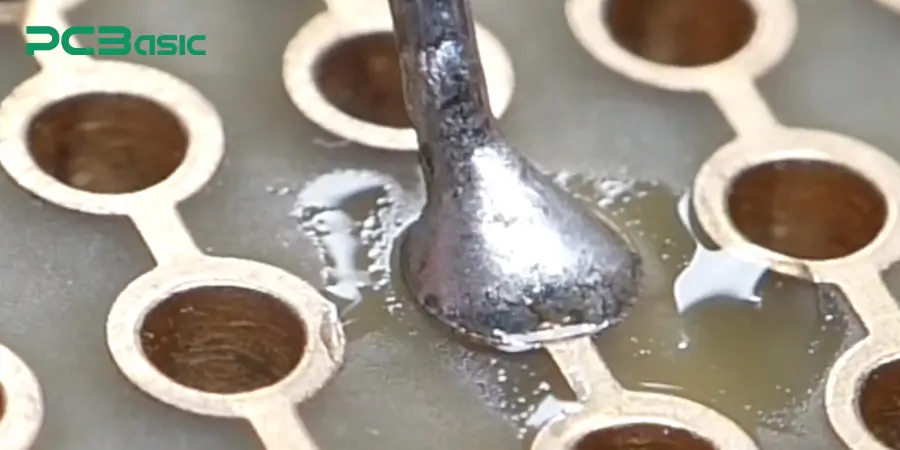
Yes, lead solder is solder containing lead. Lead solder paste is mainly composed of an alloy of tin (Sn) and lead (Pb), with a common ratio of Sn63/Pb37, which is an eutectic alloy of 63% tin and 37% lead. The melting point of this alloy is clear and its performance is stable, which is conducive to controlling the soldering process.
√ Easier to Handle: Due to its low melting point and wide process window, lead-based solders are easier to work with and suitable for various operating conditions.
√ Solder Joint with High Reliability: especially suitable for applications with extremely high reliability requirements, such as aerospace, military and industrial electronics.
√ Easier to Rework: Lead-based solder is easier to reheat and reshape and is ideal for prototyping and product rework.
× Environment and Health Issues: Lead is a toxic metal. For environmental protection and health considerations, many countries have imposed restrictions on leaded solder in regulations (such as the RoHS Directive).
× Limited Use: Leaded solder has been banned in most consumer electronics and is still permitted only in certain industrial or military fields.
× Should be Properly Handled: Using lead solder requires good ventilation and proper waste disposal to prevent health risks.
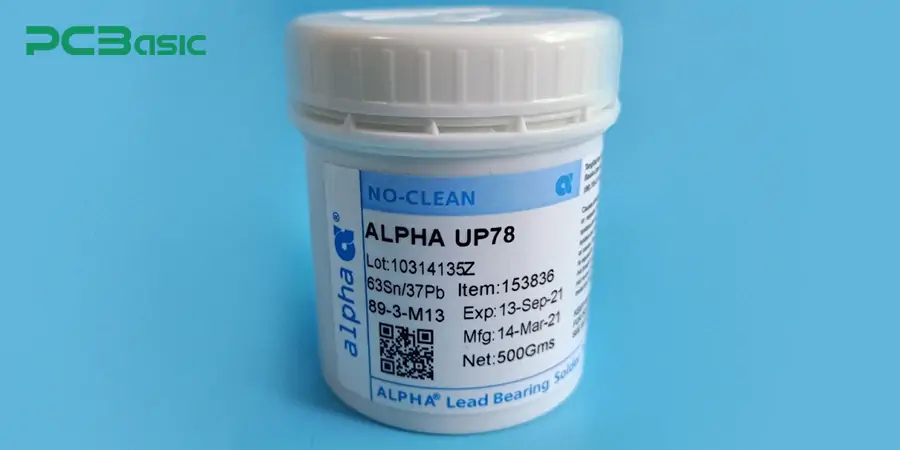
Kester 24-6337-8800: A well-known Sn63/Pb37 lead-based solder paste with stable performance and high reliability.
AIM Sn63/Pb37: Good wettability, smooth solder joints, and highly suitable for high-reliability PCB assembly.
Alpha OM-338T: Professional-grade leaded solder paste, widely used in aerospace and defense fields.
Leaded solder remains the preferred material in certain special industries and is widely used in military, aerospace and industrial systems where high reliability of solder joints, low thermal stress and good rework performance are required, especially in situations exempted from RoHS regulations. It is also often used in rework and maintenance because it is easy to operate and highly reliable. Therefore, after comprehensively considering the application requirements of the project, regulatory compliance and long-term performance, it is still possible to choose lead-based solder.
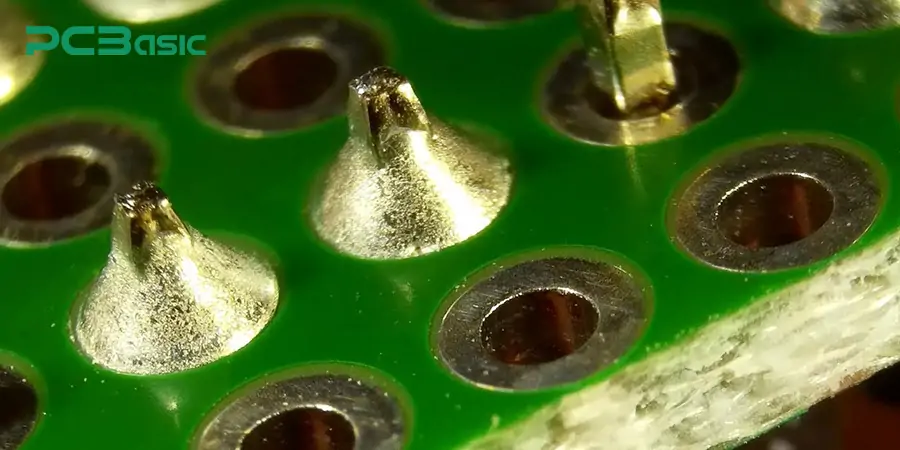
Lead-free Solder is a soldering material that contains no Lead (Pb) and is mainly composed of tin (Sn), often with small amounts of silver (Ag), copper (Cu), or other metal elements. Among them, the most common alloy is SAC305 (96.5% tin, 3.0% silver, 0.5% copper). There are also other alloys such as SnCu and SnAg, all of which comply with the RoHS and WEEE environmental protection standards.
The main feature of lead-free solder is that it contains no lead elements, which complies with global environmental protection standards such as RoHS and WEEE. High melting point: the typical melting point of lead-free solder (such as SAC305) is approximately 217-221°C. Good mechanical strength: suitable for soldering scenarios with high temperature and high reliability requirements. A variety of forms available: lead-free solder paste, solder wire and solder rods, etc.
√ Environmentally Friendly and Non-toxic: Lead-free solder paste contains no lead, which is not only safer for producers and end users, but also reduces environmental pollution.
√ Conformity with International Regulations: Conformity with RoHS standards, lead-free solder paste products can meet sales requirements in multiple markets including the European Union, the United States and Asia.
√ Supporting Green Manufacturing: The use of lead-free solder paste helps achieve sustainable and green product design.
× High Melting Point: It poses certain challenges to thermosensitive components, requiring a higher reflow temperature and energy consumption.
× Narrow Process Window: More sensitive to temperature changes, requiring more precise temperature control management.
× High Difficulty in Rework: During the rework process, lead-free solder paste is even more difficult to remelt and adjust.
× Slightly Higher Material Cost: for instance, SAC305 contains silver and its cost is higher than that of ordinary lead-containing solder.
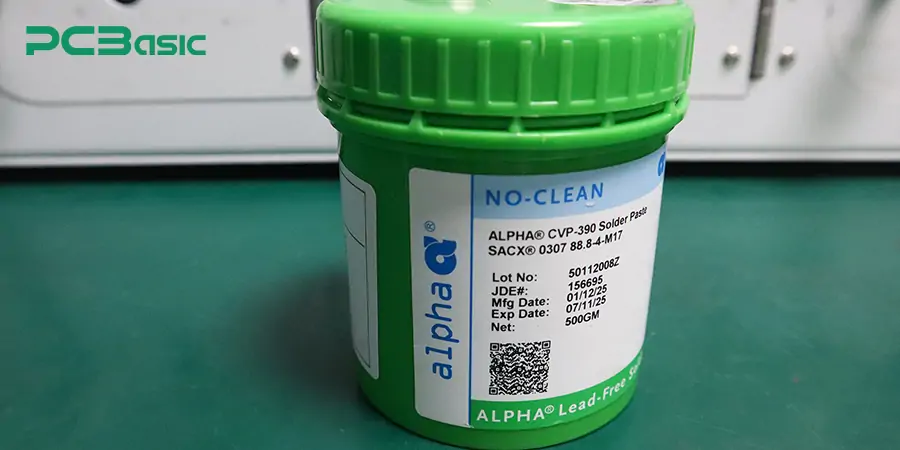
Alpha OM-550 - A high-performance lead-free solder specially designed for fine pitch, featuring excellent thermal stability and wettability.
Indium8.9HF - A no-cleaning, halogen-free and lead-free solder paste launched by Indium, suitable for high-reliability products.
Loctite GC 10 - Lead-free solder paste with high performance and long-lasting storage launched by Henkel Company.
KOKI S3X58-M500C - KOKI brand from Japan, with excellent printability and solder joint consistency.
Lead-free solder is an environmentally friendly product developed to replace traditional leaded solder. Although lead-free solder paste poses certain challenges in terms of temperature control and rework, its reliability and safety have been widely verified in fields such as consumer electronics, automotive electronics, and medical devices. Due to environmental protection and health considerations, most electronic products must use lead-free materials. Therefore, when choosing lead-free or leaded solder, manufacturers should take into account regulatory requirements, thermal sensitivity, reworkability and environmental goals.
The choice between leaded and lead-free solder will directly affect the reliability, environmental compliance and production efficiency of the product. A thorough understanding of the difference between lead-free solder and lead solder before making a choice will help you make a more rational decision.
|
Comparison Aspect |
Leaded Solder |
Lead-free Solder |
|
Melting Point & Processing Temperature |
Approx. 183°C |
Approx. 217–221°C |
|
Impact on Heat-Sensitive Components |
More suitable, lower risk |
Higher temperature may damage components |
|
Wettability |
Better, with fuller and neater solder joints |
Slightly inferior, but modern pastes are optimized |
|
Solder Joint Strength |
Good, easy to form joints |
Can match or exceed leaded solder in strength |
|
Solder Joint Reliability |
Excellent ductility, strong crack resistance |
High reliability achievable, but demands precise process control |
|
Shelf Life |
Longer, less demanding storage conditions |
Shorter, requires low-temperature and anti-oxidation storage |
|
Reworkability |
Wide process window, easy to rework |
Requires precise temperature control and skilled operation |
|
Material Cost |
Lower |
Higher due to silver content (e.g., SAC305) |
|
Equipment Requirements |
Compatible with standard reflow ovens |
Needs higher thermal capability, increasing equipment cost |
|
Compliance Certification |
Requires RoHS exemption |
Naturally RoHS compliant, suitable for global markets |
|
Health & Environmental Impact |
Toxic due to lead, requires strict safety and disposal measures |
Non-toxic and eco-friendly, better for green manufacturing |
|
Regulatory Compliance |
Restricted in many regions |
Fully compliant with RoHS, WEEE, etc. |
|
Typical Applications |
Military, aerospace, legacy industrial systems |
Consumer electronics, medical devices, automotive, etc. |
|
Component Suitability |
Better for high-density or heat-sensitive components |
Preferred in environmentally regulated production lines |
|
Selection Criteria |
Cost-effective, easier for rework |
Aligns with global compliance and sustainability trends |
One of the most crucial differences between leaded and lead-free solder paste is melting point. The melting point of lead solder is approximately 183°C, while the melting point of lead-free solder is generally between 217 and 221°C. This means that when dealing with thermosensitive components, lead-based solders have more advantages, while lead-free solders require higher temperature control accuracy.
In terms of composition, lead solder is mostly an Sn63/Pb37 alloy; lead-free solder is usually SAC305 (tin-silver-copper alloy). Lead-free solder is usually composed of non-toxic metals, which not only ensures electrical conductivity but also meets environmental protection standards.
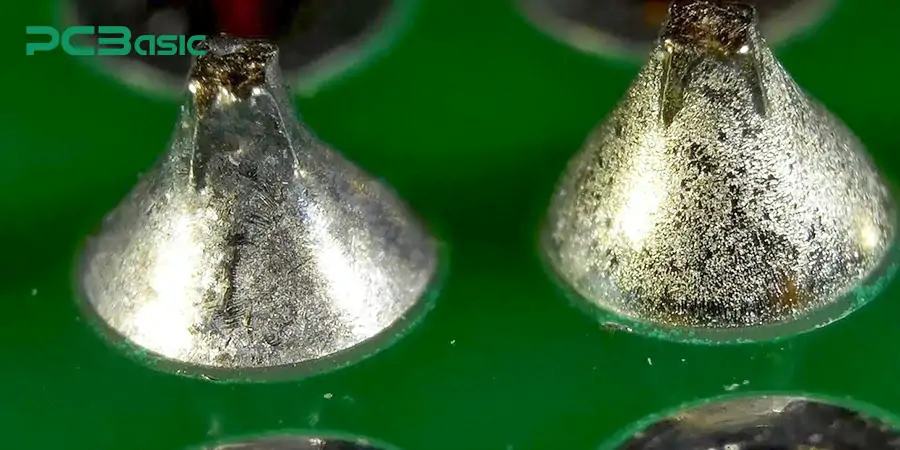
In terms of soldering effect, leaded solder has better wettability, full and smooth solder joint appearance; But modern lead-free solder paste has made breakthroughs in solder joint strength, with some brands even surpassing leaded products.
From the perspective of reliability, lead solder and lead-free solder have their merits. Lead solder has strong ductility and good crack resistance, and is suitable for the long-term use of old military and industrial equipment. Lead-free solder is more compliant with environmental regulations such as RoHS and WEEE and is preferred in consumer electronics, automotive, medical devices and other fields.
Against the backdrop of growing global emphasis on green manufacturing, companies generally consider the choice of lead-free or lead solder as the first step towards sustainability. Using lead-free solder not only avoids the risk of RoHS violations, but also helps to enhance the brand’s social responsibility.
|
Aspect |
Leaded Solder Paste |
Lead-Free Solder Paste |
|
Compatibility with Legacy Equipment |
Highly compatible with traditional processes and older components |
Less compatible, may require process redesign |
|
Suitable for Frequent Rework |
Easier to rework, larger process window |
Harder to rework due to high temperature, risk of component damage |
|
User-Friendliness |
Wide process margin, more forgiving for beginners |
Requires precise temperature control and skilled handling |
|
Visual Inspection |
Shiny joints, easier for manual inspection |
Duller appearance, harder to detect issues visually |
|
Regulatory Restrictions |
Restricted in most consumer electronics |
Fully compliant with RoHS/WEEE and global standards |
|
Environmental Impact |
Toxic due to lead content, requires special waste handling |
Non-toxic, ideal for green manufacturing |
|
Brand Image |
May be seen as outdated or environmentally unfriendly |
Reflects corporate social responsibility, enhances export credibility |
|
Sustainability Alignment |
Poor fit for long-term environmental goals |
Strong alignment with green, sustainable practices |
|
Support for Advanced Technologies |
Not suitable for cutting-edge packaging like BGA |
Better suited for modern soldering processes and technologies |
So, should one choose leaded or lead-free solder paste? The answer depends on your product goals. If you are pursuing environmental protection, for prototype sampling, standardization, global export and keeping up with mainstream trends, lead-free solder is undoubtedly a better choice. However, in frequent rework or special fields (such as aerospace and military industry), lead solder still has its value of existence. The choice between lead vs. lead-free solder is not only a trade-off of cost and process, but also relates to the future development path of the product.

At PCBasic, we offer comprehensive circuit board assembly services, supporting both leaded and lead-free solder paste soldering requirements. From material selection to soldering process control, we strictly supervise to ensure that the products meet performance and regulatory requirements. Welcome to contact us for quotations and customized service support. PCBasic always prioritizes soldering performance and regulatory compliance. Based on product requirements and customer specifications, we will flexibly select leaded solder paste and lead-free solder paste to ensure the best assembly effect in different application scenarios.
The choice between leaded and lead-free solder is directly related to the reliability of the product, environmental compliance and overall manufacturing efficiency. Although lead solder has a lower melting point, a wider rework window and excellent wettability, lead-free solder is more in line with contemporary environmental regulations, facilitating the entry of products into the global market, and at the same time represents a more sustainable manufacturing path. A thorough understanding of the differences between them—such as melting point characteristics, solder joint performance, and applicable scenarios—can help you make more rational and scientific decisions.
In conclusion, when choosing lead-free solder or leaded solder, a comprehensive trade-off should be made to select the soldering solution that best suits your product positioning and market strategy.

Assembly Enquiry
Instant Quote